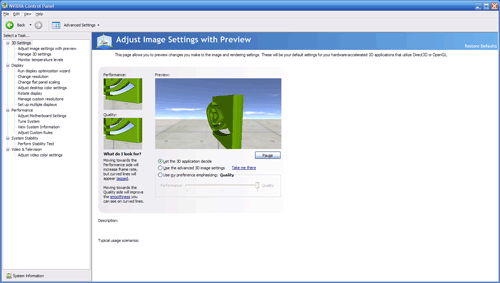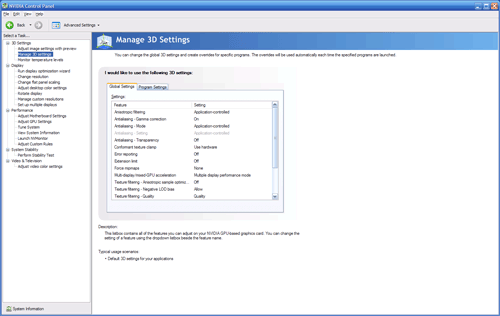Getting the Most Out Of Your Hardware: Video Card Utility Roundup
by Ryan Smith on July 5, 2007 12:00 PM EST- Posted in
- GPUs
NVIDIA Control Panel & nTune
NVIDA's utility set earns the special distinction of being by far the largest download out of all of the utilities we're looking at today. While we can't isolate the exact size of the package because they bundle their NVIDIA Control Panel with their drivers, and their nTune application for both their video cards and motherboards, the net weight of the package is a massive 82MB. The actual memory usage of this varies depending on what sub-controls are accessed, we've seen it use as little as 16MB when using text based controls, or as high as 45MB when using the image preview controls, the latter putting it on par with the Catalyst Control Center. The load times for the application average several seconds on our test system, which is faster than the Catalyst Control Center but slower than any of the third-party utilities we're looking at.
As we noted previously, NVIDIA's utilities are split in to two parts as a result of the preparation work they did for Vista. The Forceware driver package comes with the NVIDIA Control Panel which offers adjustments to 3D settings, displays, and colors, while the nTune package contains all of the controls for overclocking, system tuning, and hardware monitoring. Since nTune supports video cards and motherboards it has an easy time meeting the criteria we laid out earlier about what to expect in a video card utility, however as an NVIDIA product designed for NVIDIA motherboards, it's somewhat impotent when placed on a non-NVIDIA motherboard as compared to a third-party utility like ATI Tray Tools or RivaTuner. For the remainder of this article, we'll simply refer to these two packages as the combined NVIDIA utility set.
Although we're focusing on advanced features for enthusiasts here, it should be mentioned how similar the basic and advanced modes of the NVIDIA utility set are. Whereas we accused the Catalyst Control Center of being too basic earlier, we accuse NVIDIA of being too advanced. ATI does a far better job of laying out their controls for basic users and using image previews to showcase what effects various 3D settings will have.
Like ATI, NVIDIA offers excellent monitor and video quality controls, where the difference lies is in those important features we identified earlier. 3D settings offers control over the usual anti-aliasing and anisotropic filtering, but also offers control over threading optimization and more importantly triple buffering. As a nice touch on the side, the 3D settings sub-control also lists what each feature does.
More importantly, these options carry over into NVIDIA's game profile system, which allows custom per-game settings. Here the profile system is both a curse and a blessing due to some design issues, SLI controls, and its integration with nTune. Profiles are required for using SLI since SLI generally needs to be configured differently for each game; NVIDIA includes pre-programmed profiles for most new games but SLI control for non-profiled games is lacking.
This feeds into a more general UI problem where the spacious settings panel is split into two parts: a list of profiles and the settings for that profile. Neither is large enough to comfortably work with, and the profile list in particular is only big enough to show four profiles at once among hundreds of profiles. This is just bad UI design even for the lower standards we'd hold for a video card utility. Last, nTune and the NVIDIA Control Panel aren't integrated here at all, requiring the user to create separate profiles in different parts of the utility set for 3D settings and for hardware performance settings; other utilities such as ATI Tray Tools manage to mix these controls without difficulty. While these issues aren't enough to make the profile system unusable, it's an area for improvement for NVIDIA.
On hardware performance, NVIDIA offers decent overclocking controls but not surprisingly doesn't offer the advanced (and likely hardware breaking) features that third-party utilities can offer. Thankfully clock frequencies are not heavily constrained; we could try to take our 8800GTX to the silly speeds of 1152/1100 if we want, which is more than enough headroom to get the most out of our card. Fan control is also available for some cards.

For monitoring all of this performance NVIDIA offers a decent external application that can keep track of system and GPU temperatures. Unfortunately it's probably the ugliest utility we've ever seen, using a clone of Mac OS X's brushed metal and breaking most Windows UI conventions in the process. A stability tester/artifact scanner is also offered, along with an automatic overclocking application. Serious overclockers will likely want to use another tool; it's fine for mild overclocks but if you're approaching the edge of stability NVIDIA's artifact scanner doesn't appear to be nearly as aggressive at heating up the GPU as ATITool's is.
On the whole NVIDIA's utility set is respectable but not notably impressive. Unlike the Catalyst Control Center it has enough advanced features that most users can get by on it but there are still better options. All things equal, third-party utilities can offer the same features with a fraction of the bloat or load times, but for those who don't find the bloat a major nuisance it will do what they need. For everyone else there's RivaTuner.












17 Comments
View All Comments
Wwhat - Saturday, July 7, 2007 - link
Unfortunately MS forced people to get obscure updates you had to search for, that installed lots of DRM(-updates) for DXVA to work and have 'purevideo' enabled in many common utilities like WMP.And vista has its share of such pain too I understand due to it being thick with DRM, if anything is not 100% in line with MS's demands (or should I say sony/WB's?) it will simply not work right, often without much notification.
xsilver - Thursday, July 5, 2007 - link
i know ati tool works for both nvidia and ati but what about the rest?also
"and individual cards cost up to $900, what is another half-million spent on making a new utility to go with said GPUs?"
this comment was particularly funny - i doubt these 3rd party tools were made with anywhere near that $$$
gigahertz20 - Thursday, July 5, 2007 - link
*Takes out bat and hits xsilver in head**THONK!!!!*
Duh, he was talking about the companies you idiot. None of these 3rd party applications have a budget of anything!!!. They are completely free.
xsilver - Thursday, July 5, 2007 - link
yes exactly -you misunderstood what I wrote
what it takes 3rd party makers a few thousand dollars (ok maybe more)
it takes nvidia and ati half a million.
thats funny no?
Ryan Smith - Thursday, July 5, 2007 - link
It's just a really simple estimate, don't think too hard on it. I'm figuring NV would need 3 full time people (2 programmers, 1 QA), and various fractions of management and engineering resources to get the job done. By the virtue of being a company, NV immediately encounters costs that a single guy working in his spare time doesn't have, but it also means that NV could build a better utility since they know the hardware inside and out(at the cost of making the whole thing slightly more expensive to develop).kmmatney - Friday, July 6, 2007 - link
They probably need more resources than that, especially just to get drivers signed off by Microsoft...gigahertz20 - Thursday, July 5, 2007 - link
Enjoyed this article, it's amazing to think these big companies cannot produce utilites for their very own video cards that can beat out 3rd-party applications. They create these complex million line code drivers, but yet that can't create an application that will let you overclock your video card and test it out like ATITool does? It would be nice to have one driver by each company (AMD and Nvidia) that let's you perform all tweaks 3rd party apps let you do and don't consume lots of hard drive space and memory....and it should have an easy to use intuitive iPhone like interface....The perfect AMD or Nvidia driver, small size, lots of features, consumes little system resources, intuitive interface = perfect
That's why uTorrent is one of the most popular torrent clients, the programmers for these large corportations need to get with it!